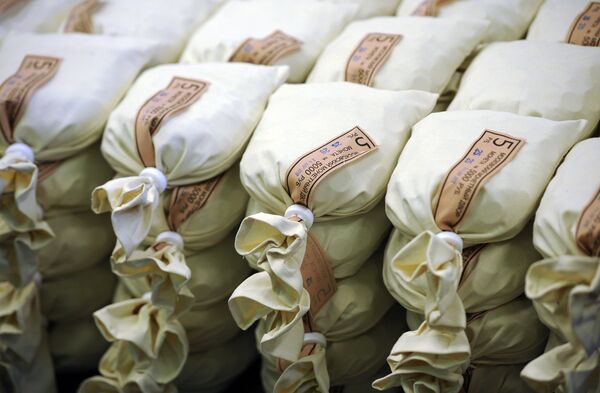The Goznak Moscow Mint celebrates its 70th anniversary on April 25. It has played its part in all the major events of the second half of the 20th century.
In the post-war period, the mint issued medals and orders. In 1957, when Moscow was preparing to host the World Festival of Youth and Students, the mint received an order for the mass production of various types of commemorative badges. In 1975, the mint began production of commemorative coins for the 1980 Olympic Games. In 1983, the mint began producing token coins. Currently, its products range from limited edition commemorative coins, including those dedicated to the 2014 Olympics, to state decorations, souvenirs and much more.
How money is made
The mint continues to have restricted access. Those lucky enough to get permission to enter the site have to go through a number of checks and leave all their change at the entrance. The majority of the staff changes into uniforms before entering the mint.
The floor where coins, medals and orders are produced takes up most of the plant. It is the main attraction for delegations and journalists. It’s never quiet in the huge hangar. Special vehicles carry workpieces to coining presses and cart off 200-kilogram boxes filled with new coins. The staff is always eager to talk about the manufacturing process.
They say, for instance, that the smaller the coin the faster it is to produce. A coining press can produce 850 10-kopeck coins or 600 five-rouble coins a minute. Engineers monitor the operation of coining presses and bear responsibility for defective production. They cannot check every coin, of course, but they conduct random checks.
Defective coins will be deformed and melted down. The defective coins that make it past the inspectors are sought after by collectors of modern Russian coins. The production staff sees these collectors’ hunt for unusual coins as kind of fetish.
Smell of money
Working on the production floor of a mint is not easy. Some get a headache because of the constant noise of pouring coins. Nor is it easy to get used to the peculiar smell of melted metal and oil.
“It’s the smell of money,” the workers say with a laugh.
The staff actually thinks that the biggest downside to working on the production floor is the noise. So everybody gets earplugs, not to mention milk, juice and other beverages to keep them happy.
Newly minted coins are then delivered to the packaging floor. Machines pack coins in canvas sacks, each filed with around five kilos of coins. Using canvas sacks is another tradition of the Moscow Mint. Nobody knows exactly why they first started using sacks instead of the boxes, bags or rolls used in foreign countries. The sacks are made in such a way that any attempt to cut them open becomes apparent immediately.
Masters of craft
Mikhail Chertov has worked at the Moscow Mint for 48 years. He likes mentoring new workers and remembering the past.
“My hands have touched all these items at many stages, from die-cutting and annealing to the coining of orders, medals and decorations. There was so much work in those times and the work was always interesting,” Chertov recalls. Awarded with the Order of Labor Glory, 2nd and 3rd class, Chertov was transferred from the pressing floor to the position of compression unit operator. Now he also does mentoring and shares his experience with apprentices. He compares coining to baking bread.
In his time at the mint, he has enjoyed working on orders most of all. He has made the Order of Lenin, the Order of Courage and the Order of the Red Banner. Even now, Chertov always watches state decoration awarding ceremonies on TV. “I don’t want to boast but whenever I see an awarding ceremony my heart skips a beat because I am part of it,” he admits.
Silence is golden
The mint is now preparing for the 2014 Winter Olympic Games in Sochi. It is currently producing several types of commemorative coins, such as a 100-ruble gold bullion coin depicting a Leopard, an official mascot of the 22nd Winter Olympic Games.
Workers call the floor where precious metal coins are produced “the golden floor.” The atmosphere is different there. There is no noise and fuss of the day-to-day coin production floor. The coins are pressed manually.
“An engineer uses forceps to pick up a workpiece of the right size and put it under the press that embosses both sides,” Valery Artamonov, head of the coin/medal/order floor, comments. This is how a rectangular coin is made.
It is the first time rectangular coins have been produced at the Moscow Mint. The Olympics is a special occasion, so the coins must be special as well.
New gold coins will be thoroughly checked for any defects. After the examination, the coins will be packed in individual capsules. Now the coining is finished. The Sberbank official site quotes the cost of a 100-ruble bullion coin as 33,000 rubles.
The Moscow Mint will soon begin producing other types of commemorative coins, including 50-ruble gold coins and 3-ruble silver coins.

